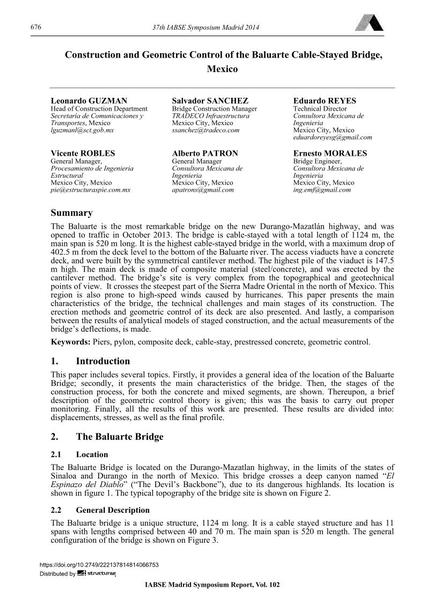Construction and Geometric Control of the Baluarte Cable-Stayed Bridge, Mexico

|
|
|||||||||||
Bibliografische Angaben
| Autor(en): |
Leonardo Guzman
Salvador Sanchez Eduardo Reyes Vicente Robles Alberto Patrón Ernesto Morales |
||||
|---|---|---|---|---|---|
| Medium: | Tagungsbeitrag | ||||
| Sprache(n): | Englisch | ||||
| Tagung: | IABSE Symposium: Engineering for Progress, Nature and People, Madrid, Spain, 3-5 September 2014 | ||||
| Veröffentlicht in: | IABSE Symposium Madrid 2014 | ||||
|
|||||
| Seite(n): | 676-683 | ||||
| Anzahl der Seiten (im PDF): | 8 | ||||
| Jahr: | 2014 | ||||
| DOI: | 10.2749/222137814814066753 | ||||
| Abstrakt: |
The Baluarte is the most remarkable bridge on the new Durango-Mazatlán highway, and was opened to traffic in October 2013. The bridge is cable-stayed with a total length of 1124 m, the main span is 520 m long. It is the highest cable-stayed bridge in the world, with a maximum drop of 402.5 m from the deck level to the bottom of the Baluarte river. The access viaducts have a concrete deck, and were built by the symmetrical cantilever method. The highest pile of the viaduct is 147.5 m high. The main deck is made of composite material (steel/concrete), and was erected by the cantilever method. The bridge’s site is very complex from the topographical and geotechnical points of view. It crosses the steepest part of the Sierra Madre Oriental in the north of Mexico. This region is also prone to high-speed winds caused by hurricanes. This paper presents the main characteristics of the bridge, the technical challenges and main stages of its construction. The erection methods and geometric control of its deck are also presented. And lastly, a comparison between the results of analytical models of staged construction, and the actual measurements of the bridge’s deflections, is made. |
||||
| Stichwörter: |
Pylon
|
||||
